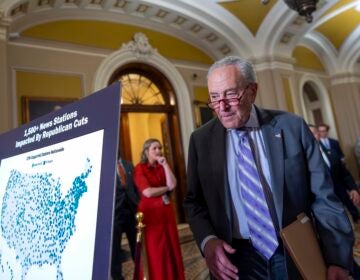Senate Democrats plan a vote to change the filibuster. So what is it?

In these episodes of Ron's Office Hours, Ron Elving explains the filibuster. (NPR)
In a video series originally published in 2017, NPR explains the filibuster – a 60-vote threshold for most legislation in the Senate. We’re bringing this explainer back now that Senate Democrats and President Biden are talking about changing the rule in an effort to pass a set of voting rights bills.
You can watch the video above and also read on, for even more detail.
The filibuster hasn’t been immune to change — though doing so is exceptionally controversial given the power it wields. It used to be a rare and powerful tool for lawmakers when they wanted to hold up the normal course of business.
But as rules changed to require fewer votes to shut one down, senators began to invoke it as a regular threat. And as the Senate came to accept the “virtual” or “silent filibuster,” it became the normal course of things. It also became the chief weapon empowering the minority party and, just as important, the individual senator.
What is the filibuster and why is it used?
It’s a senator or group of senators exercising their right to unlimited debate. If pursued in earnest, it can keep a piece of Senate business off the floor indefinitely. The chamber’s majority leader can either remove the issue at hand from consideration or file a motion to invoke cloture.
That motion takes 60 votes to succeed. That is why you constantly hear that it takes 60 votes to get anything done in the U.S. Senate. If 60 votes or more are available, cloture is invoked and a set period of debate ensues — followed by a debate on the issue itself.
What is the history of the filibuster?
The requirement to invoke cloture was originally two-thirds of the Senate. That was established when the Senate’s tradition of unlimited debate (dating back to the first decade of the 1800s) was reformed in 1917. The rules were changed because a handful of anti-war senators were objecting to the arming of merchant ships against German submarines.
The filibuster was presented in a more romantic light as the last resort of an idealistic Senate freshman in the 1939 movie Mr. Smith Goes to Washington.
But throughout the middle decades of the 20th century, the filibuster was the final weapon of Southern Democrats who were battling to preserve segregation and Jim Crow practices in their states. It bottled up or watered down various civil rights bills until 1964, when a coalition of Republicans and Democrats from outside the South mustered the two-thirds majority needed to break it. That made possible the Civil Rights Act of 1964 and the Voting Rights Act of 1965.
A decade later, in a further effort to weaken the filibuster, the supermajority required for cloture was lowered in 1975 to three-fifths, or 60 votes in a 100-seat Senate. In a classic example of unintended consequences, however, this reform led to yet more frequent use of “extended debate” or the threat of a filibuster.
Senate leaders no longer required filibustering senators to hold the floor for hours, so the drama of all-night sessions that might last for weeks has faded into memory. Senators in both parties came to embrace the filibuster, or the threat to filibuster, as just another tool.
For the first 50 years it existed, the cloture motion was only filed a few times a year at most (never more than seven times in a two-year cycle). But in the last 50 years, cloture motions have gone from dozens to scores per year. Thus far in this Senate cycle, after a little more than a year, there have been 181 cloture motions filed.
It can be debated whether the filibuster makes the chamber more or less partisan, but it surely empowers the minority party and even the individual senator.
How could it change?
With their effort to pass voting rights bills jammed in the Senate, some Democrats have recently backed everything from a return to the “talking filibuster” to carving out an exception for a simple majority vote on a single issue — such as voting rights. But changing Senate rules would require the backing of all the current Senate Democrats, two of whom — West Virginia Sen. Joe Manchin and Arizona Sen. Kyrsten Sinema — have said they oppose doing so. Sinema reiterated her position on January 13, even as President Biden was preparing to visit the Capitol and argue for change on behalf of voting rights legislation Republicans are blocking.
With the current rules under pressure, Republicans have pushed back, arguing that changing the rules would hurt any chance for bipartisanship going forward. Keep in mind: views on changing the filibuster can depend on who holds power in the Senate.
The scope of the filibuster was narrowed in 2013, when a Democratic majority used a controversial parliamentary procedure to exempt presidential appointments from the longstanding “extended debate” mandate and the 60-vote rule. When they exercised this so-called “nuclear option,” they explicitly did not include presidential nominations to the U.S. Supreme Court, which remained subject to the filibuster.
Then, in 2017, after former President Trump had taken office, a Republican majority in the Senate used the same “nuclear option” procedure to exempt Supreme Court nominations from the filibuster as well. That cleared the way for Trump to fill three vacancies over the course of his term.
For more episodes of Ron’s Office Hours and to follow related coverage, like the NPR Politics Facebook page and subscribe to NPR’s YouTube channel.
9(MDAzMzI1ODY3MDEyMzkzOTE3NjIxNDg3MQ001))




